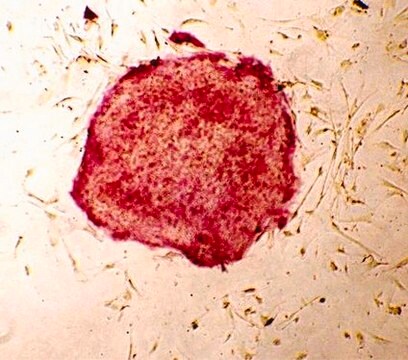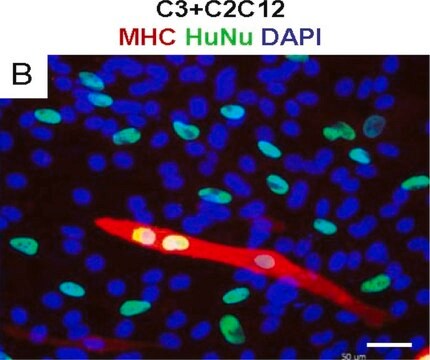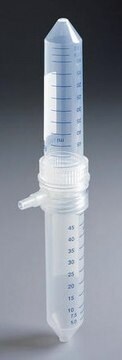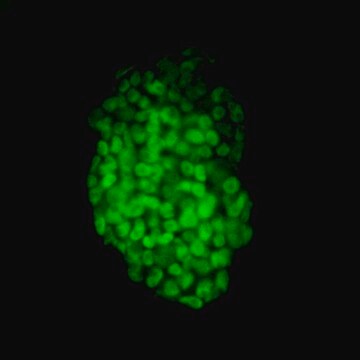SCR001
ES Cell Characterization Kit
The Embryonic Stem Cell Characterization Kit phenotypically assesses the differentiation status of ES cells by measuring their AP activity, cell-surface stage-specific antigens (SSEA-1, SSEA-4) as well as expression of TRA-1-60, TRA-1-81 antigens.
About This Item
Productos recomendados
Quality Level
species reactivity
human, mouse, rat
manufacturer/tradename
Chemicon®
technique(s)
cell culture | stem cell: suitable
immunocytochemistry: suitable
input
sample type: human embryonic stem cell(s)
sample type: mouse embryonic stem cell(s)
sample type induced pluripotent stem cell(s)
shipped in
wet ice
General description
INTRODUCTION
Stem cells have become the subject of extensive investigation recently, partly due to their therapeutic potential and because they raise several fundamental issues concerning the regulation of proliferation and differentiation.
Embryonic stem (ES) cells are derived from totipotent cells of the early mammalian embryo and are capable of unlimited, undifferentiated proliferation in vitro [Evans and Kaufman, 1981; Martin, 1981; Morrison, 1997]. Undifferentiated mouse ES cells can be maintained for an extensive period of time in media containing the cytokine, leukemia-inhibitory factor (LIF) or CHEMICON′s proprietary ES cell culture reagent, ESGRO® [Smith, 1988; Williams, 1988]. However, upon removal of LIF from the culture medium, in vitro, the mouse ES cells start to differentiate into cells derived from all three germ layers. In contrast, human ES cultures require mouse fibroblasts as feeder cells and cannot be maintained with LIF for self-renewal [Thomson and Marshall, 1998; Shamblott, 1988].
The undifferentiated state of the embryonic stem cell is characterized by a high level of expression of alkaline phosphatase (AP) [Pease, 1990] and the stem cell transcription factor, Oct-4. Nevertheless, these ES cells also exhibit marked differences from their murine counterparts in regards to their expression of stage-specific embryonic antigen (SSEA), that typify undifferentiated human ES and embryonic carcinoma (EC) cells.
SSEA-1, a carbohydrate antigen, is a fucosylated derivative of type 2 polylactosamine and appears during late cleavage stages of mouse embryos. It is strongly expressed by undifferentiated, murine ES cells [Solter and Knowles, 1978; Gooi, 1981]. Upon differentiation, murine ES cells are characterized by the loss of SSEA-1 expression and may be accompanied, in some instances, by the appearance of SSEA-3 and SSEA-4 [Solter, 1979]. In contrast, human ES and EC cells typically express SSEA-3 and SSEA-4 but not SSEA-1, while their differentiation is characterized by downregulation of SSEA-3 and SSEA-4 and an upregulation of SSEA-1 [Andrews, 1984; Fenderson and Andrews; 1987]. Undifferentiated, human ES cells also express the keratin sulphate-associated antigens, TRA-1-60 and TRA-1-81 [Andrews and Banting, 1984].
CHEMICON′s ES Cell Characterization Kit (Catalog number SCR001) is a specific and sensitive tool for the phenotypic assessment of the differentiation status of ES cells by measuring their AP activity, cell-surface stage-specific antigens (SSEA-1, SSEA-4) as well as expression of TRA-1-60, TRA-1-81 antigens.
Application
Stem Cell Research
Components
Napthol AS-BI phosphate solution (4mg/mL) in AMPD buffer (2mol/L), pH 9.5 (Part No. 90234). One 15mL bottle.
MS X SSEA-1, IgM, clone MC-480 (Part No. 90230). One vial containing 100μl of 1mg/mL monoclonal antibody.
MS X SSEA-4, IgG, clone MC-813-70 (Part No. 90231). One vial containing 100μl of 1mg/mL monoclonal antibody.
MS X TRA-1-60, IgM, clone TRA-1-60 (Part No. 90232). One vial containing 100μl of 1mg/mL monoclonal antibody
MS X TRA-1-81, IgM, clone TRA-1-81 (Part No: 90233). One vial containing 100μl of 1mg/mL monoclonal antibody.
Storage and Stability
Legal Information
Disclaimer
signalword
Warning
hcodes
Hazard Classifications
Carc. 2 - Eye Irrit. 2 - Skin Irrit. 2
Storage Class
10 - Combustible liquids
Certificados de análisis (COA)
Busque Certificados de análisis (COA) introduciendo el número de lote del producto. Los números de lote se encuentran en la etiqueta del producto después de las palabras «Lot» o «Batch»
¿Ya tiene este producto?
Encuentre la documentación para los productos que ha comprado recientemente en la Biblioteca de documentos.
Nuestro equipo de científicos tiene experiencia en todas las áreas de investigación: Ciencias de la vida, Ciencia de los materiales, Síntesis química, Cromatografía, Analítica y muchas otras.
Póngase en contacto con el Servicio técnico










